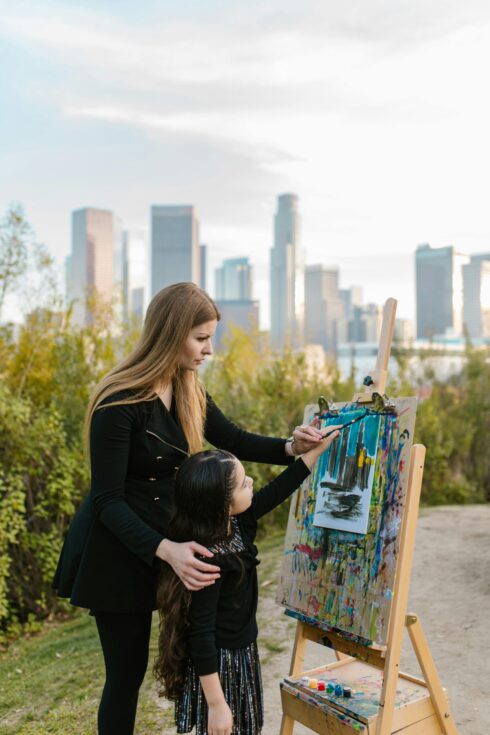Art Therapy: How Art Therapy Helps with Emotional Healing
Art Therapy is a unique form of psychotherapy that utilizes creative processes to help individuals express themselves and address various emotional issues. By engaging in artistic activities, people can explore their feelings, improve self-awareness, manage stress, and enhance overall mental well-being. This article delves into how Art Therapy aids in emotional healing, discussing its benefits, techniques, and applications.
Understanding Art Therapy
Art Therapy combines traditional therapeutic techniques with the creative process to improve mental health. This form of therapy is facilitated by professional art therapists who are trained to use art as a medium for healing.
1. Expression Through Creativity: Art Therapy allows individuals to express emotions that might be difficult to verbalize. The creative process becomes a safe outlet for expressing feelings and thoughts.
2. Therapeutic Process: During Art Therapy sessions, individuals engage in various artistic activities such as drawing, painting, sculpting, or collage-making. These activities are guided by the therapist to help individuals explore their emotions and gain insights into their psychological state.
The Benefits of Art Therapy
Art Therapy offers numerous benefits for emotional healing and overall mental health. Some of the key advantages include:
1. Emotional Release: Creating art provides a way to release pent-up emotions and reduce emotional stress. The act of creating can be cathartic, allowing individuals to process and let go of negative feelings.
2. Enhanced Self-Awareness: Engaging in Art Therapy helps individuals gain a better understanding of their emotions, thoughts, and behaviors. This increased self-awareness is crucial for emotional healing and personal growth.
3. Stress Reduction: The creative process involved in Art Therapy can be calming and meditative, helping to reduce stress and anxiety. Focusing on artistic activities allows individuals to shift their attention away from worries and immerse themselves in the present moment.
4. Improved Communication: Art Therapy can enhance communication skills, especially for those who find it challenging to express themselves verbally. Artistic expression provides an alternative way to convey emotions and experiences.
5. Building Self-Esteem: Creating art and seeing tangible results can boost self-esteem and confidence. This sense of accomplishment is particularly beneficial for individuals struggling with low self-worth.
Techniques Used in Art Therapy
Art Therapy employs various techniques to facilitate emotional healing. Some common techniques include:
1. Free Drawing and Painting: Individuals are encouraged to draw or paint whatever comes to mind. This spontaneous creation helps to uncover unconscious thoughts and emotions.
2. Mandala Drawing: Creating mandalas (circular designs) can be a soothing and centering activity. Mandala drawing is often used to promote relaxation and mindfulness.
3. Collage Making: Using different materials to create collages allows individuals to explore their feelings and experiences in a visual and tactile way. Collage making can also help in organizing thoughts and memories.
4. Sculpting: Working with clay or other sculpting materials provides a hands-on approach to expressing emotions. Sculpting can be particularly helpful for those who find it difficult to articulate their feelings.
5. Guided Imagery: In this technique, the therapist guides the individual through a visualization exercise, prompting them to create art based on their imagined experiences. This method helps in exploring deeper emotional layers.
Applications of Art Therapy
Art Therapy is used to address a wide range of emotional and psychological issues. Some common applications include:
1. Trauma and PTSD: Art Therapy is effective in helping individuals process traumatic experiences. It provides a non-verbal outlet for expressing pain and fear, aiding in trauma recovery.
2. Anxiety and Depression: Engaging in creative activities can alleviate symptoms of anxiety and depression. Art Therapy helps individuals manage their emotions and develop coping strategies.
3. Grief and Loss: Art Therapy offers a way to express grief and work through the complex emotions associated with loss. Creating art can be a healing process for those dealing with bereavement.
4. Behavioral Issues: For children and adolescents, Art Therapy can address behavioral problems by helping them understand and manage their emotions. It also enhances social skills and self-regulation.
5. Chronic Illness: Art Therapy is beneficial for individuals with chronic illnesses, providing emotional support and improving quality of life. It helps in coping with the psychological impact of long-term health conditions.
Conclusion
Art Therapy is a powerful tool for emotional healing, offering a creative and non-verbal approach to psychotherapy. By engaging in artistic activities, individuals can explore and express their emotions, reduce stress, and enhance self-awareness. The benefits of Art Therapy extend to various psychological issues, making it a versatile and effective therapeutic modality.
For those interested in exploring Art Therapy, finding a qualified therapist is crucial. To learn more and read reviews on online therapy options, visit find a therapist.
**Sources:**
1. Psychology Today – Art Therapy
2. NCBI – The Effectiveness of Art Therapy
3. Verywell Mind – What Is Art Therapy?
Must Read News
The Benefits of Couples Therapy
The Benefits of Couples Therapy: Strengthening Relationships Through Communication and Understanding Maintaining a healthy and [...]
5 Ways to Know If You or a Loved One Need Therapy
5 Ways to Know If You or a Loved One Need Therapy In today’s world, [...]
Talk Therapy: What It Is and How It Helps
Talk Therapy: What It Is and How It Helps Talk therapy, also known as psychotherapy, [...]
Group Therapy Near Me: The Power of Collective Healing
Group Therapy Near Me: The Power of Collective Healing Group therapy is an increasingly popular [...]
What is Cognitive Behavioral Therapy
What is Cognitive Behavioral Therapy? Cognitive Behavioral Therapy (CBT) is a widely recognized and evidence-based [...]
The Value of Teletherapy vs. Face-to-Face Therapy: Choosing the Right Fit for You
The Value of Teletherapy vs. Face-to-Face Therapy: Choosing the Right Fit for You The landscape [...]
Our Method
We use a combination of consumer reviews and overall scores from multiple online platforms such as Forbes, Trustpilot, Google, Indeed, Glassdoor, and others to form an overall composite score that shows how well a company not only treats its customers but how they treat their employees as well. Our multiplatform composite score prevents companies from gaming one review-generating platform or another for good scores. We believe this method provides the best overall social proofing.

